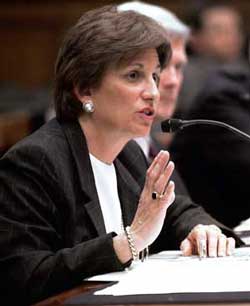DHS Special Report | Watch-list data converges at Terrorist Screening Center


Connecting state and local government leaders
Although Donna Bucella prefers to stay out of the limelight, her job doesn't allow it. As director of the Terrorist Screening Center, Bucella oversees one of the most important data sets in the Bush administration's war on terror'the consolidated Terrorist Screening Database.

Donna Bucella
TSC also maintains the government's
no-fly lists and is the key point of contact
to determine whether someone applying
for a visa could be a suspected terrorist.
Bucella, a prosecutor by trade, admits
she does not give interviews often, but
she spoke to GCN for a few minutes
about the TSC's creation, how it maintains
the database, and plans for the
database's evolution.
GCN: How do you gather information and get agencies to work together?
BUCELLA: People sometimes think that you
just have to go knock on the different
agencies and say, 'Give me your list, give
me your list,' and it [would be] all nice
and neat, formatted and everything else.
[But] the information was all over the
government. And I think through a real,
genuine exercise, many different agencies
in the intelligence community and law enforcement
really did [take] a good look at
what ... they had and what they needed.
It is sort of like, 'What do you have,
what do you need?' 'Well, I don't know
what I need unless I see what you have.'
And it is really getting many different cultures,
both in the intelligence and law enforcement
communities, to understand
what the other is really saying.
We've operated in different worlds and
different vocabularies, and used the same
words with different meanings. Putting the
law enforcement and intelligence communities
in the same room, saying the same
things, has been an interesting exercise.
GCN: How does the screening center interact with other screening and targeting initiatives such as the Homeland Security Department's U.S. Visitor and Immigrant Status Indicator Technology program?
BUCELLA: Well, U.S. Visit, when they stood
up, [former program manager] Jim
Williams and I talked a lot early on. But
we were more interested in making sure
those biometrics [collected by U.S. Visit]
got into a system that was accessible to
everybody, which it is. So while I may not
have the U.S. Visit prints in my database,
if they have the name and a print, I know
where to go. Because of our borders, we
have a very good relationship with DHS,
its different agencies and programs. That
relationship, because of the newness of
everyone, gets solidified as we mature.
GCN: How do agencies submit their data to you, and how do you deal with false positives?
BUCELLA: We get it on a list. ... We have
access to [the National Counterterrorism
Center's classified Terrorist Identities
Datamart Environment database
and systems maintained by the FBI and
State Department]. Information does
change all the time, and you want to
make sure you're looking at the most
current information.
And we have a quality review process
here, where we take a look at where
someone's been watch-listed, and maybe
some of the information might be outdated
or maybe there's a person that
keeps being re-encountered.
GCN: How do you see the TSC evolving?
BUCELLA: What we're trying to have is a
queryable database where [the agencies]
can query directly in here. What we're doing
now with state and local police officers,
through the National Crime Information
Center, [is] upload names of all known and
suspected terrorists, so when an officer is
pulling names, it will first search if there are
already warrants on the individual.
What we're trying to do is get to where
someone queries the NCIC, and the NCIC
can hit against our database. So instead of
pushing information out, everybody will
be querying us. ... It's really opening up the
world, getting that information and putting
it into some sort of format that everyone
can use in an understandable form.




